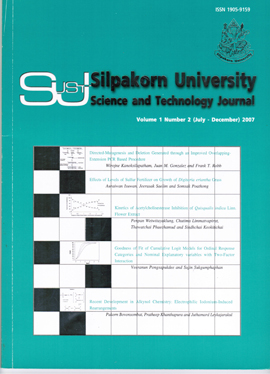Recent Development in Alkynol Chemistry: Electrophilic Iodonium-Induced Rearrangements
Main Article Content
Abstract
Recent development in iodonium-induced reactions of alkynols is discussed and analysed herein. ClassicalMeyer-Schuster and Rupe rearrangements are described as a background to the main body of iodonium-inducedreactions. α-Iodoenones derived from rearrangement of alkynols, known herein as the Iodo Meyer-Schusterreaction, links the classical Meyer-Schuster reaction to the novel reaction of iodonium-induced rearrangement ofalkynols. The rearrangements leading to the formations of β-haloenones and β,β-dihaloenones and enals arediscussed with mechanistic considerations, which include stereospecificity of the migrating group and themigratory aptitude differences between the phenyl and the alkyl groups. The role of solvents – namely the watercontent in organic solvent – is presented with mechanistic consideration of the role of the allenol, the haloniumbridge cation intermediates and water in dictating each different reaction pathways. The application of therearrangement reaction to biological interesting molecules such as glucofuranose and xylofuranose is discussed. Haloetherification reaction, the third type of halonium-induced alkynol reaction, was found to be the exclusivereaction in the halogenation of alkynol derivative of hexofuranoses.
Downloads
Article Details
References
Angara, G. J. and Mc Nelis, E. (1991). α-haloenones from secondary alkynols. Tetrahedron Letters, 32(19): 2099-2100.
Angara, G. J., Bovonsombat, P., and Mc Nelis, E. (1992). Formations of β,β-dihaloenones from halogenated tertiary alkynols. Tetrahedron Letters, 33(17): 2285-2288.
Blandino, M. and Mc Nelis, E. (2002). Rearrangements of Haloalkynol Derivatives of Glucofuranose. Organic Letters, 4(20): 3387-3390.
Bovonsombat, P., Angara, G. J., and Mc Nelis, E. (1992). Use of Koser’s reagent for the iodination of the rings of polyalkylbenzenes. Synlett, (2): 131-132.
Bovonsombat, P. and Mc Nelis, E. (1992). Formations of mixed β,β-dihaloenals from halogenated secondary alkynols. Tetrahedron Letters, 33(50): 7705-7708.
Bovonsombat, P. and Mc Nelis, E. (1993a). Ring halogenations of polyalkylbenzenes with N-halosuccinimide and acidic catalysts. Synthesis, (2): 237-241.
Bovonsombat, P. and Mc Nelis, E. (1993b). Ring expansions of alkynyl cyclopentanols with iodine and Koser’s reagent. Tetrahedron, 49(8): 1525-1534.
Bovonsombat, P. and Mc Nelis, E. (1993c). Ring expansion of an α-bromoalkynol camphor by means of iodine and Koser’s reagent. Tetrahedron Letters, 34(27): 4277-4280.
Bovonsombat, P. and Mc Nelis, E. (1993d). Conversions of phenyl alkynylcyclopentanols toα-iodoenones. Tetrahedron Letters, 34(51):8205-8208.
Bovonsombat, P. and Mc Nelis, E. (1994). A new approach to the functionalization of phenanthrenequinone. Tetrahedron Letters, 35(35): 6431-6432.
Bovonsombat, P. and Mc Nelis, E. (1995). Formation of a dihaloenone of homoadamantanone. Synthetic Communications, 25(8): 1223-1229.
Chabardes, P. (1988). Titanium-copper and titanium-silver catalysts for the isomerization of α-acetylenic alcohols to α,β-ethylenic carbonyl derivatives. Tetrahedron Letters, 29(48): 6253-6256.
Chinchilla, R. and Najera, C. (2007). The Sonogashira Reactions: A booming methodology in synthetic organic chemistry. Chemical Reviews, 107(3): 874-922.
Djuardi, E. and Mc Nelis, E. (1999). Furo [3,4-b] furan formations from alkynols of xylose. Tetrahedron Letters, 40(40): 7193-7196.
Djuardi, E., Bovonsombat, P., and Mc Nelis, E. (1994). Ring expansion of 2-haloethynyl-2-norbornanols. Tetrahedron, 50(41): 11793-11802.
Edens, M., Boerner, D., Chase, C. R., Nass, D., and Schiavelli, M. D. (1977). Mechanism of the Meyer-Schuster Rearrangement. Journal of Organic Chemistry, 42(21): 3403-3408.
Erenler, R. and Biellmann, J.- F. (2005). Facile conversion of pyridine propargylic alcohols to enones: stereochemistry of protonation of allenol. Tetrahedron Letters, 46(34): 5683-5685.
Herault, X. and Mc Nelis, E. (1996). Ring expansion of 1-haloethynyl-2-methylcyclopentanols. Tetrahedron, 52(31): 10267-10278.
Herault, X. and Mc Nelis, E. (1997). Solvent effects of the rearrangements of tertiary alkynols. New Journal of Chemistry, 21(3): 377-382.
Janas, J. J., Asirvatham, E. T., and Mc Nelis, E. T. (1985). Phenyl shifts to vinyl cations formed by iodination of alkynes. Tetrahedron Letters, 26(16): 1967-1968.
Koser, G. F. (2001.) [Hydroxy (tosyloxy) iodo] benzene and closely related iodanes: The second stage of development. Aldrichimica Acta, 34(3): 89-102.
Lopez, S. S., Engel, D. A., and Dudley, G. B. (2007). The Meyer-Schuster rearrangement of ethoxyalkynyl carbinols. Synlett, (6): 949-953.
Marchand, P., Rajagopal, D., Burrit, A., Bott, S. G., Watson, W. H., and Sun, D. (1995). Highly regioselective hypervalent iodine mediated ring cleavage and ring expansion of some pentacyclo [5.4.0.02,6.03,10.05,9] undecane derivatives.Tetrahedron, 51(43): 11673-11680.
Stille, J. K. (1985). Palladium catalyzed coupling of organotin reagents with organic electrophiles. Pure and Applied Chemistry, 57(12): 1771-1780.
Suzuki, A. (1991). Synthetic studies via the cross-coupling reaction of organoboron derivatives with organic halides. Pure and Applied Chemistry, 63(3): 419-422.
Swaminathan, S. and Narayanan, K. V. (1971). The Rupe and Meyer-Schuster rearrangements. Chemical Reviews, 71(5): 429-438.
Varvoglis, A. (2001). Hypervalent Iodine in Organic Synthesis, Academic Press, New York.
Yamabe, S., Tsuchida, N., and Yamazaki, S. (2006). Active role of hydrogen bonds in Rupe and Meyer-Schuster rearrangements. Journal of Chemical Theory and Computation, 2: 1379-1387.


